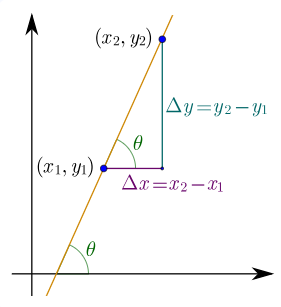 Home
Home
 Back
Back

Definition: This calculator determines various properties of a line given two points, including the slope (m), y-intercept, angle of inclination (θ), percentage grade, distance between the points (d), and the differences in x and y coordinates (Δx, Δy).
Purpose: It is used in mathematics, engineering, and physics to analyze the steepness of lines, calculate inclines, and understand linear relationships.
The calculator uses the following formulas to compute the properties of the line:
Slope (m):
Y-intercept (b):
Angle (θ, degrees):
Percentage Grade (%):
Distance (d):
Distance between x's (Δx) and y's (Δy):
Steps:
Slope calculations are essential for:
Example 1: Calculate the properties of a line passing through points (0, 0) and (1, 1):
Example 2: Calculate the properties of a line passing through points (2, 3) and (5, 9):
Q: What happens if x1 equals x2?
A: The slope becomes undefined (vertical line), and the calculator will display an error message.
Q: Why is the percentage grade useful?
A: It provides a practical measure of steepness, often used in construction and engineering for roads and ramps.
Q: Can this calculator handle negative coordinates?
A: Yes, the calculator works with any real numbers for coordinates, including negative values.